Aerial View from south-west © Marc Hillesheim, Cologne
Nestled idyllically in one of Italy’s oldest cultural landscapes, in an area where mountain rivers form a delta and flow into the Mediterranean Sea, Riviera Airport situated some 60 kilometres east of Monaco beckons air travelers approaching the coast through azure blue skies. There was a time when the skies above this airport were criss-crossed with the white contrails that aircraft of the Italian Air Force lefy behind like brush strokes on a blue canvas. This former military airfield known as Albenga Airport will celebrate its 100th anniversary in 2022. It has a long association with military achievements, industrial breakthroughs as well as civilian endeavours. This mythical runway which contributed to the legend of Italian aviation was put up for sale five years ago. With about one hundred airports already run by the state, Italy is trying to reduce this number by allowing some partial privatisations as well as various rehabilitation project. Riviera Airport however is an exception. Its total privatisation is part of an experiment and a case study for the Italian government, which agreed to allow a private investor to operate a general and business aviation hub. And the man at the helm of this perilous enterprise is Clemens Toussaint. He is German, born in Germany but a resident of Monaco.
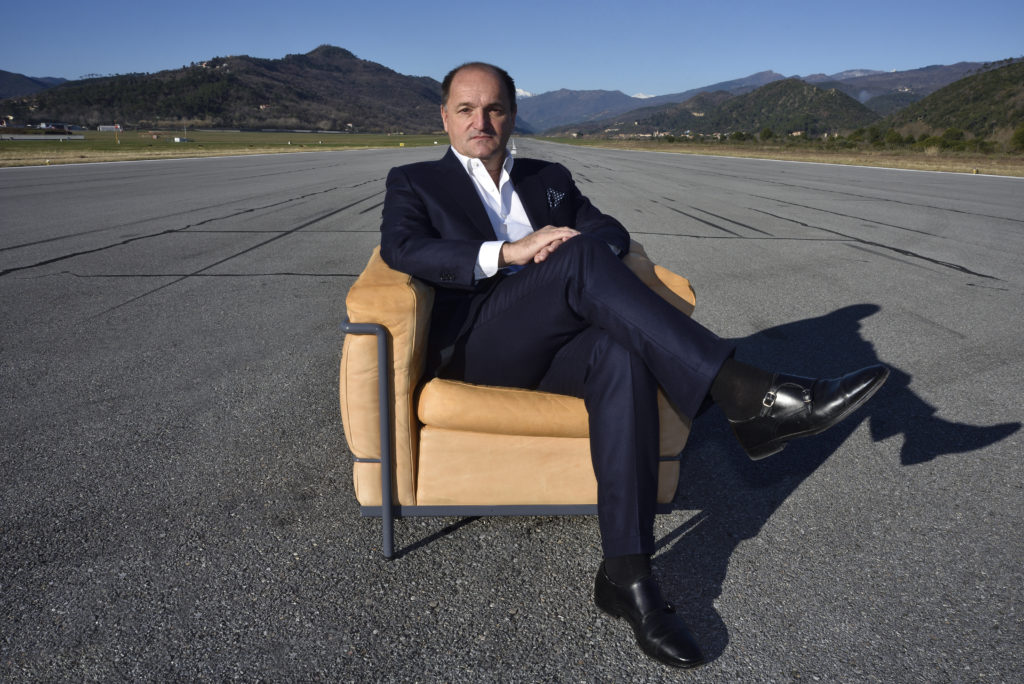
Before going into the aviation business, he was an art historian. He searched for and tracked down works of art stolen by the Nazis throughout Europe.
Very much affected by the dark past of his country, he decided to embark on a quest for justice, when he realised that the directors of certain museums who were implicated in a number of war crimes during World War II, were still in office as late as the 1960s; they had never been tried or ever punished for their crimes. What’s even more shocking is that the vast majority of them had, in total impunity, kept all the artworks among which many had been stolen from Jews during the Holocaust.
And so, Clement Toussaint took it upon himself to return these art treasures to their rightful owners or their heirs.
Rendering Internal View of Club Terminal © Milan Ingeneria Srl, Milano & Open Building Research Srl, Milano
A FLIGHT BETWEEN LUXURY AND ART
Clemens Toussaint meets us at the prestigious Monte Carlo Yacht Club. He smiles, seems at peace and appears confident. After reminiscing on thirty years of trying to heal the wounds inflicted by German history and which have also affected him, he enumerates his future projects just like a man who has regained his serenity. These stem from a vision that he has had : an airport dedicated exclusively to a high-end clientele and where it’s mostly private business jets that take off and land.
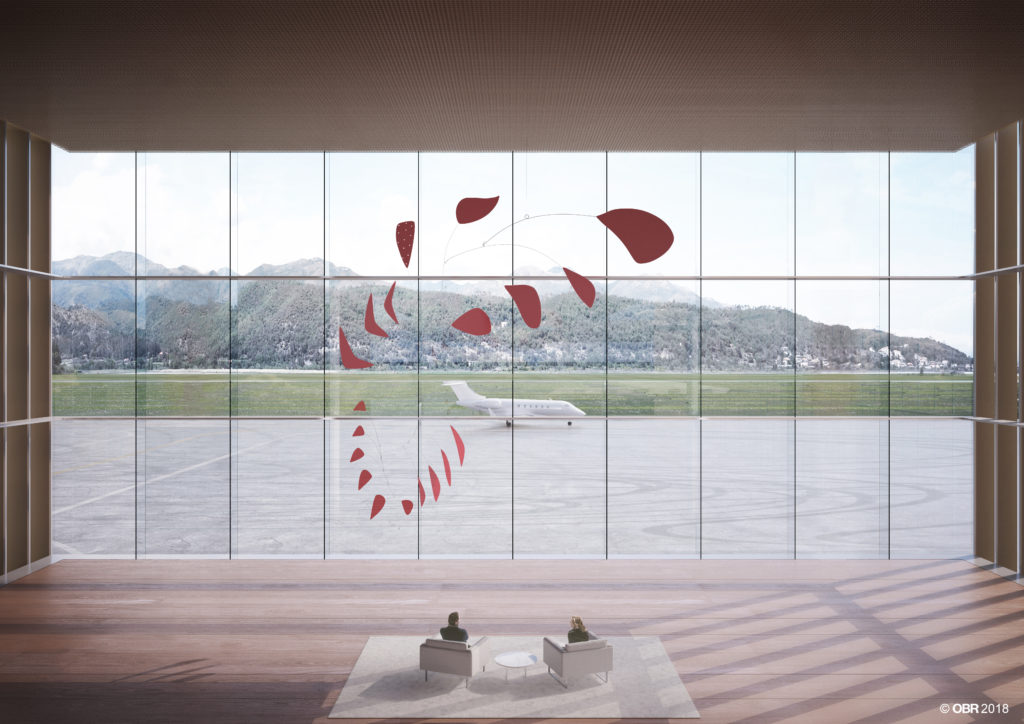
And yet, it’s impossible for him to forego his first passion which is art; he promises that many works of art – legally acquired of course – will be exhibited within the prestigious terminal. Aesthetics is at the heart of the project : “The idea is to bring back the charm of flying. Today, we take a plane like we do the metro; flying should continue to be a unique and magical experience every time”.
A NICHE MARKET
Monaco is home to a record number of some 200 private jet owners. Until now, it had faced a serious problem of storing these aircraft as there was no airport in the vicinity that would allow long term parking facilities. Although Nice Côte d’Azur Airport sees a large number of these prestigious aircraft land on its tarmac, its administrators’ policies tend to dissuade wealthy owners from parking their planes for long periods. Not only do they not apply degressive rates but on the contrary, increase the tariffs progressively when parking times are considered too long, thus making it the most expensive airport in Europe.
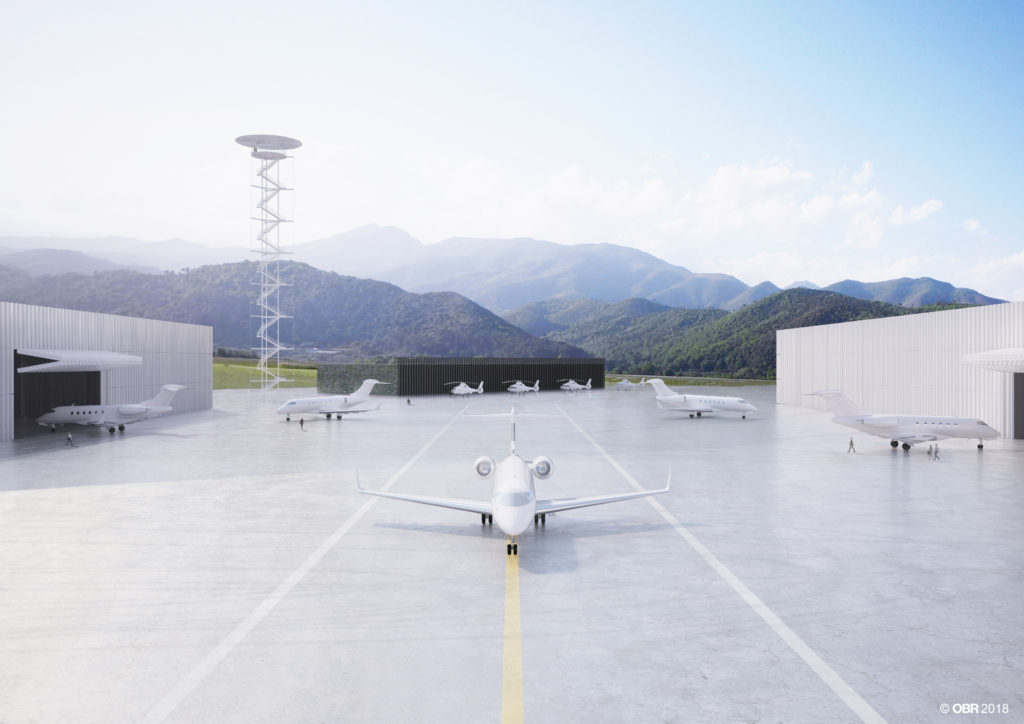
Other than these commercial considerations, Riviera Airport’s main competitor has the major disadvantage of being situated very close to the sea; its runways are actually on the water’s edge. Although this makes for spectacular views from the windows on take-offs and landings, the salty sea spray is very corrosive and causes damage to the fuselage of the parked aircraft. The result is more frequent maintenance and repair bills, taking a toll on even well-padded bank accounts. And the fact that French town planning laws prohibit Nice airport from building hangars for aircraft storage except the one for Prince Albert II of Monaco’s private jet, makes this sector a niche market with high economic potential. And it is precisely with this in mind that Clemens Toussaint launched his bid for the privatisation of Riviera Airport.
HIGH POTENTIAL BUSINESS
It was by studying the yachting sector with its insufficient docking spaces on the French Riviera, that Clemens Toussaint came up with a business plan for his airport project.Yacht owners are forced to anchor in nearby Italian ports and they would therefore become his future clientele. He reasoned that if some billionaire is prepared to travel fifty odd kilometres to board his yacht for a few hours of leisure, he would surely do the same in order to use his preferred mode of business travel; his personal jet. This can even be seen as a way of making life easier by making it shorter for him to travel from point A to point B. Before the Covid-19 crisis, Nice Côte d’Azur Airport handled on average 15 million passengers per year, with the administrators forecasting double that figure in the future. But even though these growth factors have been adversely affected, trends suggest that the private and general aviation sectors will quickly reach their operational limits at this airport.
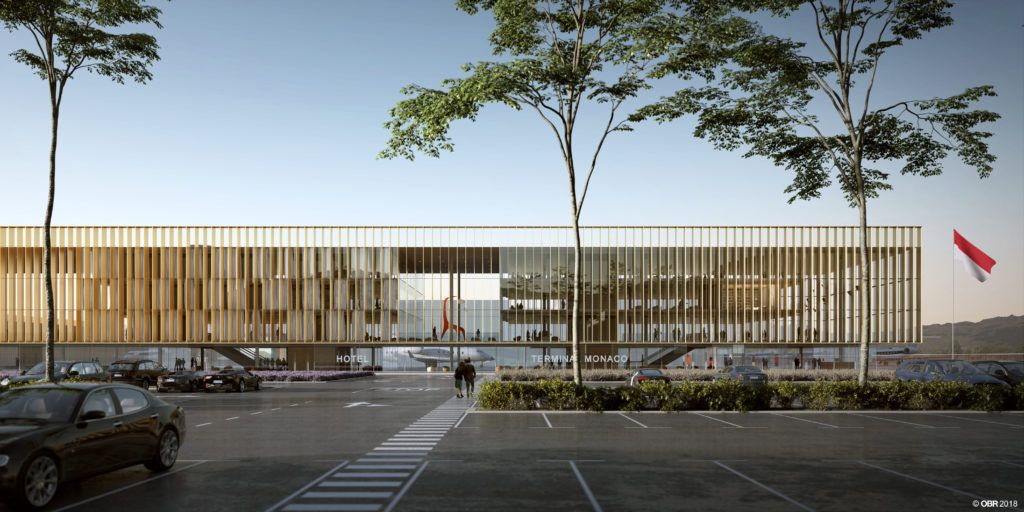
IMPORTANTS DEVELOPMENTS
The Covid-19 crisis has had a powerful, negative impact on the civil aviation sector, but Clemens Toussaint has elected to see this as a great opportunity to initiate some daring developments. It is obviously easier to undertake all kinds of construction work when the runway is almost unused, and his recent investments will allow Riviera Airport to establish its reputation as the airport with the most modern amenities. The airport, which was built in 1922 has been variously used for military, industrial and civil purposes. Up until 1962 when Genoa airport was inaugurated, it was the main airport for the region and was used mainly for general aviation. But now that it is destined to accommodate a top end business clientele, new infrastructures are of primary importance. Unlike Nice Côte D’Azur Airport, passengers can arrive at Riviera Airport by car and park right next to their private jets. Likewise, a passenger can disembark from a private jet and hop onto a helicopter in a matter of minutes. In fact, Clemens Toussaint’s conception is very different from that of traditional airports. Visitors and business travelers will no longer be overwhelmed by boutiques and advertising panels in the terminal halls. These will make way for design, modern architecture, works of art and quality food outlets. Another special feature is that Riviera is one of the first airports with concrete runways. The airport which was built during Fascist rule in Italy lies between two rivers on ground with a very solid bedrock that can support aircraft weighing up to 60 metric tons. As the majority of private jets do not exceed 50 metric tons, Riviera Airport can easily accommodate most aircraft in the private sector. What’s more, it clearly stands out from its main competitor at Cannes Mandelieu which cannot accommodate aircraft exceeding 25 metric tons. In order to allow as many people as possible to experience the feel of the new airport, modernisation work is underway this winter to lengthen the runway by 300 metres, bringing the total length to 1800 metres. Together with the added advantage of a modern surface layer for perfect water drainage and the latest systems in runway lighting technology, the airport will be able to accommodate the largest private jets.
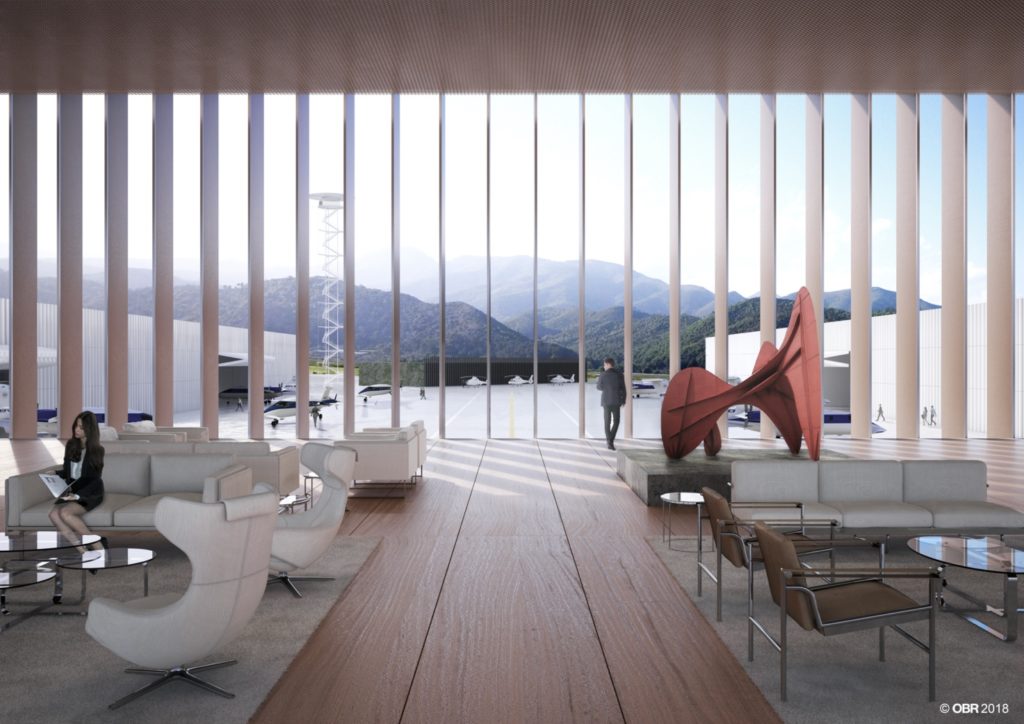
As far as the new owner is concerned, safety is the number one priority. Therefore, the very first works consisted in the setting up of GPS and GNSS virtual corridors and flight paths, allowing for an efficient and safe instrument approach. As for the aesthetic aspect of the terminal itself into which will be incorporated the tradition of slick Italian design, the building with its prestigious Milanese architectural style covers an area of almost 800 square metres. Despite the gargantuan works initiated by Clemens Toussaint, he remains modest about the quality of his building. He readily acknowledges that what makes this airport unique lies mainly in the scenery and the natural beauty of the valley between Monaco and Genoa.
THE LONG TERM VISION: AUTONOMY AND ECOLOGY
Another highlight of Riviera Airport is the construction of high security hangars. Luxury private jets are very expensive little gems that require much care. Since they spend, on average, 330 days a year parked on the ground, their owners want to see them protected from corrosion as well as prying eyes. There is a project for a 12,000 square metres common hangar that can accommodate some ten very large jets to begin with. In the next ten years, this will be converted into a handling facility which will make way for the installation of individual and custom-made hangars to suit the needs of individual tenants.

In the near future, this type of individual hangar could be used to store cars, serve as wine cellars and cigar cellars, or even a small flat for pilots in transit. In fact, all types of ancillary improvements are considered to add to the quality of service and offer the best customer experience. For the time being, all efforts are focused on improving the runway and ancillary equipment, but one can imagine how the site will look like in a few years’ time. The 100 hectares of land will be covered by a multitude of hangars, there will be a solar park producing 30 megawatts of electricity to supply the whole of the valley. Clemens Toussaint certainly has a keen interest in the development of civil aviation but he also predicts that private aviation will be among the first to act with greater responsibility in the new future. As far as he is concerned, the solution already exists : it lies in the development of synthetic kerosene, even if it costs more. Competition is fierce between airports around the world to be equipped with the best, in terms of both technological prowess and the reduction of greenhouse gases. Riviera Airport’s initial aim is to go even further by producing its own electricity and redistributing it to the whole region, as well as creating a residential park to accommodate airport staff, technicians, pilots and air crews…this will allow them to be as close as possible to their aircraft. At a later stage, the aim will be to boost social and economic activity in the valley with various infrastructures such as schools, nurseries, shops and businesses. For some, this project may seem something of a fantasy, but Clemens Toussaint relies on hard facts. The Italian Riviera, while benefiting from the same natural attractions as the French Riviera, namely the proximity of the sea and the mountains, the climate and an international clientele, is two to three times cheaper than its French counterpart in terms of the cost of living. In short, an attractive region with great potential, where much remains to be done.
DISASTER RELIEF
Riviera Airport is intended to serve essentially as a high-end private and business aviation hub. But it can also handle “premium” general aviation and more standard flights, as well as a helicopter service. Recently, the Italian civil protection and Carabinieri requisitioned part of the airfield to come to the aid of victims of ‘Storm Alex’. Once again, Riviera Airport made history by helping to save hundreds of thousands of lives.
THE CÔTE D’AZUR: AN EXTRAORDINARY STORY
Riviera Airport’s ambition is to take advantage of the niche market that is the high-end clientele. However, everyone working on this project is aware that before becoming one of its main competitors, Nice Côte d’Azur Airport was above all one of its progenitors.
One can therefore imagine that it was the construction of this first airport in 1910 that allowed the French Riviera to become a sort of promised land for major events that later became mythical : the Monte Carlo Grand Prix, created in 1929, the Cannes Film Festival in 1939, the Menton Lemon Festival in 1934, the Monte-Carlo International Circus Festival in 1974, the Monte Carlo TV Festival in 1961, or the famous Nice Jazz Festival created in 1948. Historically, it was a high speed train service (TGV) that was planned to link Paris to Nice, on the Côte D’Azur; in fact, the same technological prowess that made it possible to travel from Paris to Marseille in just three hours. At the time however, building a very high speed railway line seemed impossible or was too expensive, even for the country that first produced the train that was the envy of the world for so long.
At that time, only Parisians and Lyonnais invested in a secondary residence to spend their summer holidays on the Riviera. However, once the project for the TGV high speed line was abandoned, (editor’s note : even today, the TGV trains linking Marseille to Nice run at reduced speeds) another solution had to be found. And that’s when the project for this airport began to take shape. At the time, the international dimension that this seaside airstrip would achieve was unimaginable.
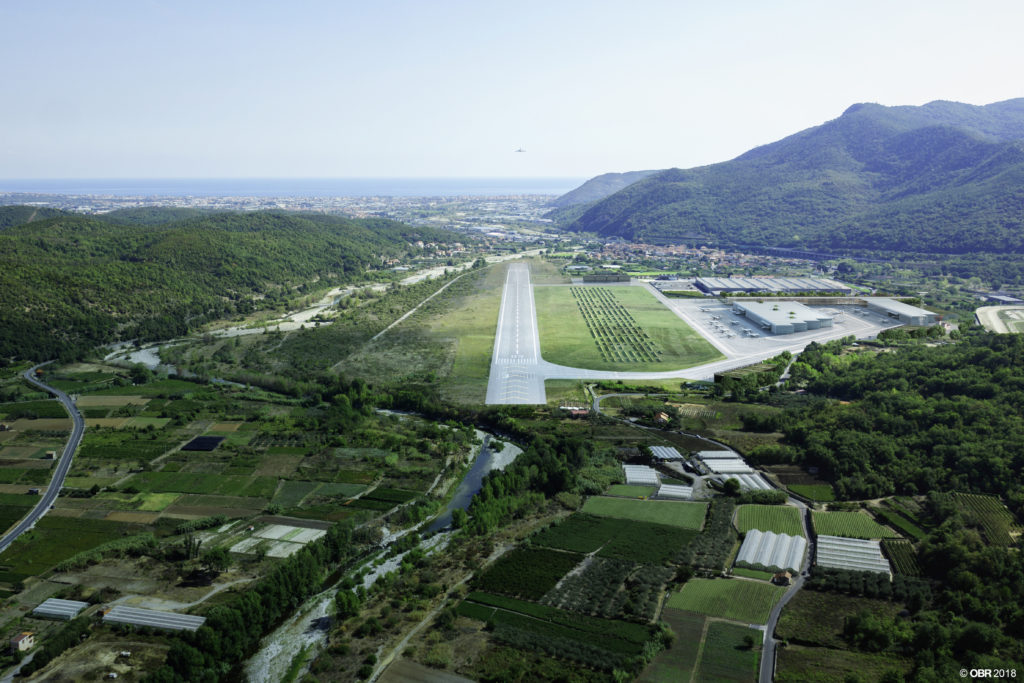
The Côte d’Azur’s reputation throughout the world rests largely upon the aeronautics industry. Therefore, one can easily deduce that Riviera Airport owes its rebirth, at least in part, to the existence of the Nice Terminal. Clemens Toussaint considers means of transport and travel as decisive factors in the successful development of a region : “In the 19th century, at the time of the referendum to decide whether Nice should remain Italian, the decision was taken for it to become part of France because there already was a rail network linking it to Paris. It is the transport links that develop the regions”. Since the 1970s, Italy has not developed or invested in tourism-related infrastructures. So, Clemens Toussaint has decided to tackle this challenge head-on; first of all : “For Italy, so as to create a functioning structure in the context of an important, industrial sector” and then, as a resident of Monaco : “to offer its quality of services to the Principality, because 99% of our customers are Monegasques”. Currently, Cannes Mandelieu Airport handles an average of 20,000 flights per year and achieves a proportional turnover of approximately 20 million euros per year. Riviera Airport handles only 10% of this traffic, which amounts to 2,000 flights per year; there is therefore huge potential for growth. This will happen, slowly but surely. According to Clemens Toussaint, it would be a great achievement to take from Nice Côte d’Azur Airport 10% of its long haul international flights.
This would ensure sufficient income to continue the development of the airport and the planned infrastructure. And hopefully, one day…it will fly with its own wings.

